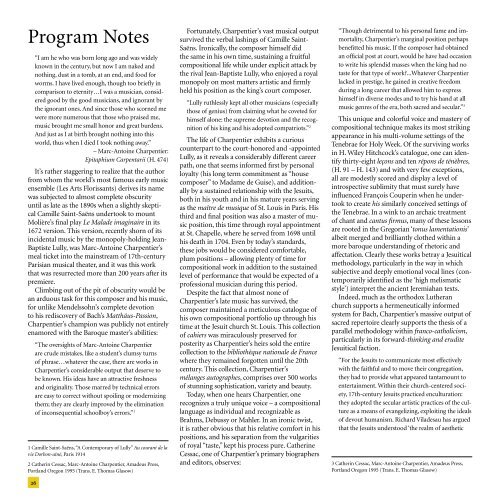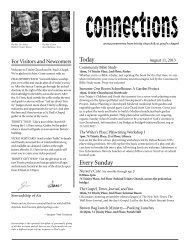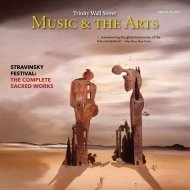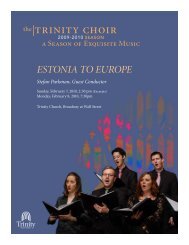Create successful ePaper yourself
Turn your PDF publications into a flip-book with our unique Google optimized e-Paper software.
Program Notes<br />
“I am he who was born long ago and was widely<br />
known in <strong>the</strong> century, but now I am naked and<br />
nothing, dust in a tomb, at an end, and food for<br />
worms. I have lived enough, though too briefly in<br />
comparison to eternity…I was a musician, considered<br />
good by <strong>the</strong> good musicians, and ignorant by<br />
<strong>the</strong> ignorant ones. And since those who scorned me<br />
were more numerous that those who praised me,<br />
music brought me small honor and great burdens.<br />
And just as I at birth brought nothing into this<br />
world, thus when I died I took nothing away.”<br />
– Marc-Antoine Charpentier:<br />
Epitaphium Carpentarii (H. 474)<br />
It’s ra<strong>the</strong>r staggering to realize that <strong>the</strong> author<br />
from whom <strong>the</strong> world’s most famous early music<br />
ensemble (Les <strong>Arts</strong> Florissants) derives its name<br />
was subjected to almost complete obscurity<br />
until as late as <strong>the</strong> 1890s when a slightly skeptical<br />
Camille Saint-Saëns undertook to mount<br />
Molière’s final play Le Malade imaginaire in its<br />
1672 version. This version, recently shorn of its<br />
incidental music by <strong>the</strong> monopoly-holding Jean-<br />
Baptiste Lully, was Marc-Antoine Charpentier’s<br />
meal ticket into <strong>the</strong> mainstream of 17th-century<br />
Parisian musical <strong>the</strong>ater, and it was this work<br />
that was resurrected more than 200 years after its<br />
premiere.<br />
Climbing out of <strong>the</strong> pit of obscurity would be<br />
an arduous task for this composer and his music,<br />
for unlike Mendelssohn’s complete devotion<br />
to his rediscovery of Bach’s Matthäus-Passion,<br />
Charpentier’s champion was publicly not entirely<br />
enamored with <strong>the</strong> Baroque master’s abilities:<br />
“The oversights of Marc-Antoine Charpentier<br />
are crude mistakes, like a student’s clumsy turns<br />
of phrase…whatever <strong>the</strong> case, <strong>the</strong>re are works in<br />
Charpentier’s considerable output that deserve to<br />
be known. His ideas have an attractive freshness<br />
and originality. Those marred by technical errors<br />
are easy to correct without spoiling or modernizing<br />
<strong>the</strong>m; <strong>the</strong>y are clearly improved by <strong>the</strong> elimination<br />
of inconsequential schoolboy’s errors.” 1<br />
1 Camille Saint-Saëns, “A Contemporary of Lully” Au courant de la<br />
vie Dorbon-aîné, Paris 1914<br />
2 Ca<strong>the</strong>rin Cessac, Marc-Antoine Charpentier, Amadeus Press,<br />
Portland Oregon 1995 (Trans. E. Thomas Glasow)<br />
26<br />
Fortunately, Charpentier’s vast musical output<br />
survived <strong>the</strong> verbal lashings of Camille Saint-<br />
Saëns. Ironically, <strong>the</strong> composer himself did<br />
<strong>the</strong> same in his own time, sustaining a fruitful<br />
compositional life while under explicit attack by<br />
<strong>the</strong> rival Jean-Baptiste Lully, who enjoyed a royal<br />
monopoly on most matters artistic and firmly<br />
held his position as <strong>the</strong> king’s court composer.<br />
“Lully ruthlessly kept all o<strong>the</strong>r musicians (especially<br />
those of genius) from claiming what he coveted for<br />
himself alone: <strong>the</strong> supreme devotion and <strong>the</strong> recognition<br />
of his king and his adopted compatriots.” 2<br />
The life of Charpentier exhibits a curious<br />
counterpart to <strong>the</strong> court-honored and -appointed<br />
Lully, as it reveals a considerably different career<br />
path, one that seems informed first by personal<br />
loyalty (his long term commitment as “house<br />
composer” to Madame de Guise), and additionally<br />
by a sustained relationship with <strong>the</strong> Jesuits,<br />
both in his youth and in his mature years serving<br />
as <strong>the</strong> maître de musique of St. Louis in Paris. His<br />
third and final position was also a master of music<br />
position, this time through royal appointment<br />
at St. Chapelle, where he served from 1698 until<br />
his death in 1704. Even by today’s standards,<br />
<strong>the</strong>se jobs would be considered comfortable,<br />
plum positions – allowing plenty of time for<br />
compositional work in addition to <strong>the</strong> sustained<br />
level of performance that would be expected of a<br />
professional musician during this period.<br />
Despite <strong>the</strong> fact that almost none of<br />
Charpentier’s late music has survived, <strong>the</strong><br />
composer maintained a meticulous catalogue of<br />
his own compositional portfolio up through his<br />
time at <strong>the</strong> Jesuit church St. Louis. This collection<br />
of cahiers was miraculously preserved for<br />
posterity as Charpentier’s heirs sold <strong>the</strong> entire<br />
collection to <strong>the</strong> bibliothèque nationale de France<br />
where <strong>the</strong>y remained forgotten until <strong>the</strong> 20th<br />
century. This collection, Charpentier’s<br />
mélanges autographes, comprises over 500 works<br />
of stunning sophistication, variety and beauty.<br />
Today, when one hears Charpentier, one<br />
recognizes a truly unique voice – a compositional<br />
language as individual and recognizable as<br />
Brahms, Debussy or Mahler. In an ironic twist,<br />
it is ra<strong>the</strong>r obvious that his relative comfort in his<br />
positions, and his separation from <strong>the</strong> vulgarities<br />
of royal “taste,” kept his process pure. Ca<strong>the</strong>rine<br />
Cessac, one of Charpentier’s primary biographers<br />
and editors, observes:<br />
“Though detrimental to his personal fame and immortality,<br />
Charpentier’s marginal position perhaps<br />
benefitted his music. If <strong>the</strong> composer had obtained<br />
an official post at court, would he have had occasion<br />
to write his splendid masses when <strong>the</strong> king had no<br />
taste for that type of work?...Whatever Charpentier<br />
lacked in prestige, he gained in creative freedom<br />
during a long career that allowed him to express<br />
himself in diverse modes and to try his hand at all<br />
music genres of <strong>the</strong> era, both sacred and secular.” 3<br />
This unique and colorful voice and mastery of<br />
compositional technique makes its most striking<br />
appearance in his multi-volume settings of <strong>the</strong><br />
Tenebrae for Holy Week. Of <strong>the</strong> surviving works<br />
in H. Wiley Hitchcock’s catalogue, one can identify<br />
thirty-eight leçons and ten répons de ténèbres,<br />
(H. 91 – H. 143) and with very few exceptions,<br />
all are modestly scored and display a level of<br />
introspective sublimity that must surely have<br />
influenced François Couperin when he undertook<br />
to create his similarly conceived settings of<br />
<strong>the</strong> Tenebrae. In a wink to an archaic treatment<br />
of chant and cantus firmus, many of <strong>the</strong>se lessons<br />
are rooted in <strong>the</strong> Gregorian ‘tonus lamentationis’<br />
albeit merged and brilliantly clo<strong>the</strong>d within a<br />
more baroque understanding of rhetoric and<br />
affectation. Clearly <strong>the</strong>se works betray a Jesuitical<br />
methodology, particularly in <strong>the</strong> way in which<br />
subjective and deeply emotional vocal lines (contemporarily<br />
identified as <strong>the</strong> ‘high melismatic<br />
style’) interpret <strong>the</strong> ancient Jeremiahan texts.<br />
Indeed, much as <strong>the</strong> orthodox Lu<strong>the</strong>ran<br />
church supports a hermeneutically informed<br />
system for Bach, Charpentier’s massive output of<br />
sacred repertoire clearly supports <strong>the</strong> <strong>the</strong>sis of a<br />
parallel methodology within franco-catholicism,<br />
particularly in its forward-thinking and erudite<br />
Jesuitical faction.<br />
“For <strong>the</strong> Jesuits to communicate most effectively<br />
with <strong>the</strong> faithful and to move <strong>the</strong>ir congregation,<br />
<strong>the</strong>y had to provide what appeared tantamount to<br />
entertainment. Within <strong>the</strong>ir church-centered society,<br />
17th-century Jesuits practiced enculturation:<br />
<strong>the</strong>y adopted <strong>the</strong> secular artistic practices of <strong>the</strong> culture<br />
as a means of evangelizing, exploiting <strong>the</strong> ideals<br />
of devout humanism. Richard Viladesau has argued<br />
that <strong>the</strong> Jesuits understood ‘<strong>the</strong> realm of aes<strong>the</strong>tic<br />
3 Ca<strong>the</strong>rin Cessac, Marc-Antoine Charpentier, Amadeus Press,<br />
Portland Oregon 1995 (Trans. E. Thomas Glasow)







